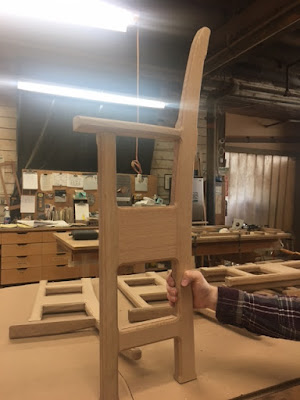skip to main |
skip to sidebar
Chapel car 5 Messenger of Peace is a signature exhibit in the Museum's Train Shed exhibit hall. Constructed in 1898 by the Barney and Smith Car Company, the Messenger of Peace is a wooden railway car that functioned as a mobile church for the American Baptist Publication Society, and later for the American Baptist Home Missions Society too. Major rehabilitation work on this National Register-listed object was completed in 2013, but the sanctuary has been lacking pews, at least until now.

Unfortunately the Museum has not had the capacity to produce replica pews while the Conservation and Restoration Center has been hosting rehabilitation of NP locomotive 924 and SP&S coach 213. So beginning last winter, journeymen cabinetmakers at OB Williams in Seattle - and their very well-equipped shop - were contracted to produce pew components, which would later be finished and assembled at the Museum. Construction is based on designs copied from an original two-seat pew held in the collection of the American Baptist Historical Society at Mercer University in Atlanta. The pews were originally installed in a 3 & 2 configuration, and the replica components will allow five full rows.

Much work remains: the pew components need to be finished with at least seven coats of shellac, and then they need to be assembled. And to keep costs down, the project (assembly and finishing) is being completed between tasks on NP locomotive 924 and SP&S coach 213. However, work is expected to wrap up early this summer.

The Northwest Railway Museum is grateful for the support that is making this project possible, including contributions from the Nysether Family Foundation, American Baptist Home Missions Society, American Baptist Historical Society, and dozens of generous individuals. Thank you also to Ms. Terry Wick at OB Williams for agreeing to take on this surprisingly complicated fabrication, especially with the attention to detail that is making each replica almost distinguishable from the original.
 The Northwest Railway Museum's railroad has many safety obligations, and chief among them are 13 public crossings. Northern Street is in downtown Snoqualmie and serves a residential neighborhood, and while it receives only light traffic, many decades of use and several major flood events that submerged the track have taken their toll. In June 2018 a project with the City of Snoqualmie began improving the crossing.
The Northwest Railway Museum's railroad has many safety obligations, and chief among them are 13 public crossings. Northern Street is in downtown Snoqualmie and serves a residential neighborhood, and while it receives only light traffic, many decades of use and several major flood events that submerged the track have taken their toll. In June 2018 a project with the City of Snoqualmie began improving the crossing. Volunteers and staff from the Museum along with a crew from Monroe Correctional removed the timber crossing planks, removed mud that had collected in the tie cribs, and set about improving the structure.
Volunteers and staff from the Museum along with a crew from Monroe Correctional removed the timber crossing planks, removed mud that had collected in the tie cribs, and set about improving the structure. The tie cribs were refilled with clean ballast, and down ties were tamped up. New crossing planks from Wheeler Lumber in South Dakota were then installed between the rails. The new planks were cut from coastal Douglas fir and treated with copper naphthenate. They were fastened in place with timber screws and by the end of the day the crossing was open to traffic.
The tie cribs were refilled with clean ballast, and down ties were tamped up. New crossing planks from Wheeler Lumber in South Dakota were then installed between the rails. The new planks were cut from coastal Douglas fir and treated with copper naphthenate. They were fastened in place with timber screws and by the end of the day the crossing was open to traffic.








